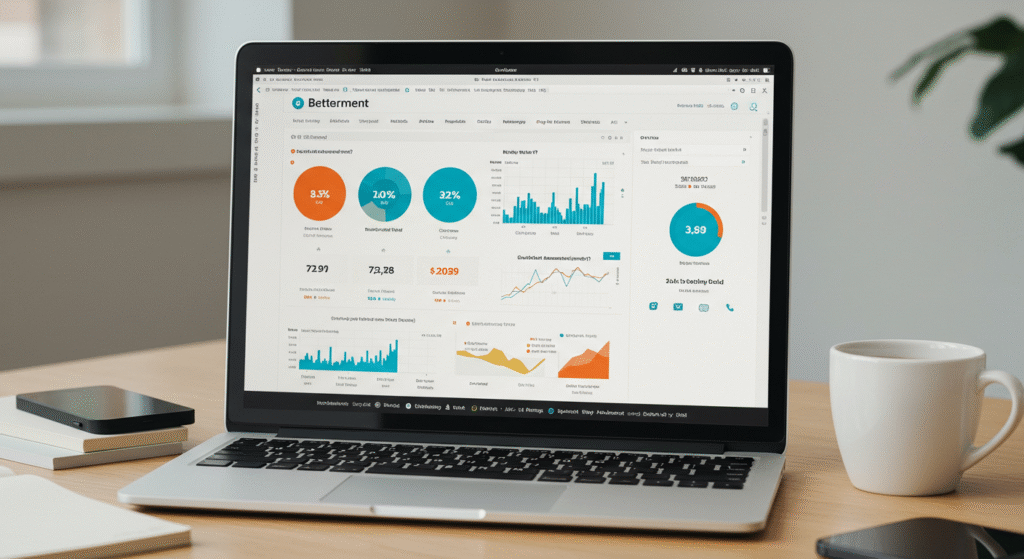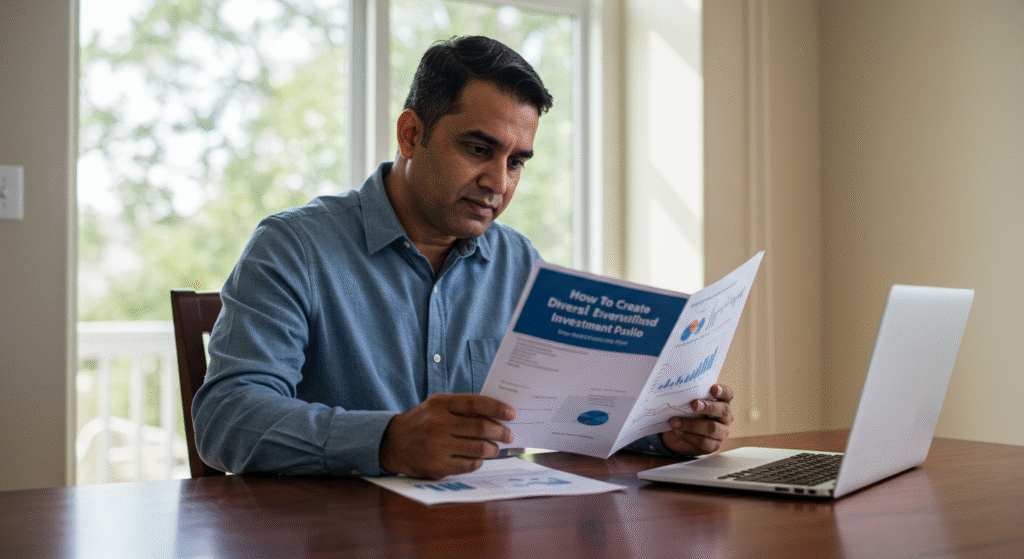Building a diversified investment portfolio isn’t just a smart move; it’s essential for managing risk and growing your wealth steadily over time. When you spread your investments across different asset types, sectors, and regions, you reduce the chance that a single setback will derail your financial progress. This article will walk you through practical steps to create a portfolio that balances growth potential with risk control.
You won’t find complicated jargon here just clear, straightforward advice designed to help you make confident investment choices. Whether you’re new to investing or looking to refine your strategy, the guidance ahead will help you build a robust and resilient portfolio that works for your goals.
Understanding Portfolio Diversification

When it comes to investing, putting all your money into one place feels risky. Like carrying all your eggs in a single basket while walking through a crowded market, one stumble could mean broken eggs. That’s why building a diversified investment portfolio is something I can’t recommend enough. It lets you spread your money across different investments, reducing the danger of big losses and helping smooth out ups and downs. Let’s break down what diversification really means and why it’s a cornerstone of smart investing.
What Is Diversification?
Diversification means spreading your investments across several types of assets instead of sticking with just one. Think of it like planting a garden with many different seeds. If one type of plant doesn’t grow well, others can thrive and keep your garden looking healthy overall. In investing, the goal is similar: by not putting all your money into a single stock or bond, you lower the chance that one bad outcome wipes out your entire portfolio.
Simply put, diversification helps you avoid the risk of concentration. Instead of betting everything on one horse, you have several horses in the race. Some might run faster on certain tracks, others on different terrains. When markets get rough, it’s those different horses that balance your race toward success.
The Role of Asset Classes
A big part of diversification is mixing different asset classes because they usually don’t move in the same direction at the same time. The main categories I focus on when building a portfolio are:
- Stocks: These represent ownership in companies. They can offer higher returns but tend to fluctuate more in value.
- Bonds: Loans to governments or companies. Bonds often provide steady income and act as a cushion when stocks face tough times.
- Cash or cash equivalents: These are safer but yield minimal returns. They offer liquidity and stability.
- Real estate: Property investments may generate income and often behave differently from stocks and bonds.
- Commodities: Things like gold or oil can hedge against inflation and add another layer of variety.
Each asset class responds differently to economic changes, market trends, and events. When you combine them, the weak spots in one type can be offset by gains in another. This balance keeps your portfolio from swinging wildly in value.
Benefits Beyond Risk Reduction
Diversification is not only about lowering risk. It can also play a key part in improving your portfolio’s overall returns. By including a mix of assets, you position your investments to capture growth opportunities wherever they arise. Some assets may lag at times, but the winners can pull your returns up.
A diversified portfolio also helps create a gentler investment journey. Instead of facing erratic changes in your account value, you experience smoother, more predictable ups and downs. This can make sticking with your long-term plan easier, especially when markets get bumpy.
In short, diversification balances risk and reward. It’s like building a sturdy boat with different materials: some parts flex, others hold firm, but together they keep you afloat no matter the waters.
Building a diversified investment portfolio means mixing the right assets, understanding how they behave, and appreciating the broader benefits beyond just protection. The foundation you set here will make every other step in smart investing more effective and less stressful.
Choosing the Right Mix for Your Investment Portfolio

Picking the right mix of investments isn’t about guessing which stock will soar or bond will pay out best this year. It’s about understanding your personal comfort with risk, your financial dreams, and how long you want to stay in the game. Every decision shapes the blend of assets that suits you best a blend that can help your portfolio grow while weathering the ups and downs of markets. Let’s look at the key pieces of the puzzle: your risk tolerance, your goals, the classic stock-bond combo, and the value of broadening your reach beyond domestic investments.
Assessing Your Risk Tolerance
Knowing how much risk you’re willing to take is the first step in building your portfolio. Risk tolerance is simply how much variability in your investment’s value you can stomach without losing sleep. Some people get nervous seeing their portfolio drop 10% even if they know it may bounce back. Others are more comfortable riding out swings if it means aiming for bigger returns.
Here’s a simple way to figure out your risk tolerance:
- Conservative: You prefer low risk and steady returns. You don’t want surprises and are okay with slower growth.
- Moderate: You can handle some ups and downs but want a reasonable balance between risk and reward.
- Aggressive: You expect higher returns and accept that your portfolio’s value will jump around quite a bit.
Imagine your portfolio is like driving a car. A conservative investor opts for steady cruising on a smooth road. A moderate investor drives on a highway with some curves. An aggressive investor tackles a winding mountain road at high speed, knowing the ride will be thrilling and bumpy.
Understanding your risk tolerance helps determine what types of investments to choose and how much of each to include.
Matching Investments to Your Goals
Your investment mix should reflect what you want to achieve and when you want to achieve it. Different goals call for different approaches:
- Long-term goals like retirement: Since you have time to recover from short-term dips, you can pick investments with higher growth potential, such as more stocks.
- Short-term goals like buying a home in a few years: Preservation of capital and avoiding loss is more important. This usually means having more bonds and cash, which are less volatile.
Think of your goals as different destinations. A trip taking decades allows you to take a few detours to scenic routes (higher risk, higher reward), while a quick trip demands that you stick to the main roads for safety.
Asset allocation shifts based on your timeline and purpose. The longer your horizon, the more you can usually lean into growth-oriented investments. Shorter horizons call for caution and stability.
Balancing Stocks and Bonds
The traditional approach often cited is a 60/40 split between stocks and bonds. This mix aims to balance growth and safety, with stocks providing the chance for higher returns and bonds offering income and less volatility.
Stocks tend to be more unpredictable but have higher upside potential. Bonds are generally steadier, paying interest along the way and often rising when stocks fall. This mix helps smooth the ride, reducing the chance of big losses while still offering growth.
You can adjust this ratio to fit your comfort level and timeline:
- Younger investors or those with high risk tolerance might choose 80/20 or 70/30 stocks to bonds.
- Older investors or conservative ones may drop to 50/50 or even 40/60 to protect capital.
The 60/40 mix is like a seesaw designed to keep your portfolio steady: when stocks take a dip, bonds help hold it up.
Including International and Alternative Assets
Sticking only to domestic stocks and bonds can limit growth and increase risk concentrated in a single economy. Adding international stocks opens your portfolio to companies and industries that might perform well when your home market slows down.
Alternative assets like real estate or commodities (gold, oil) add yet another layer of protection. They don’t always move in sync with stocks and bonds, helping your portfolio stand firm during market turbulence.
Here are the benefits of broadening your mix:
- International stocks provide exposure to growth in developing and other foreign markets.
- Real estate investments can generate income and often behave differently from stock markets.
- Commodities serve as a hedge against inflation and economic uncertainty.
By including these, you build a portfolio that’s less likely to falter all at once like having different backup systems in place in case one fails.
Choosing the right mix means looking through your own lens what you can handle, where you want to go, how long you have, and the extra diversity that strengthens your position. That mix becomes your foundation, setting the way for all the smart choices that follow.
Practical Steps to Build and Maintain Your Diversified Portfolio

Building a diversified portfolio is more than just picking a mix of assets. It’s about taking consistent, clear steps that help you keep that balance over time. I’ve found that the process becomes manageable once you have solid methods and a routine. Let’s go through practical ways to make your diversified portfolio work for you from easy starting points to keeping your investments aligned as years go by.
Starting with Index Funds and ETFs
If you’re just stepping into investing, starting with low-cost index funds and ETFs is where I always recommend you begin. These funds offer built-in diversification by pooling hundreds or even thousands of securities inside one investment. Rather than buying individual stocks, you get a slice of the entire market or a sector, making your portfolio instantly more balanced.
Here’s why these funds simplify investing, especially for beginners:
- Cost-Effective: Index funds and ETFs have minimal fees compared to actively managed funds, which helps your returns grow faster over time.
- Broad Exposure: By buying a single ETF, you can cover a wide range of industries, companies, or even global markets.
- Less Time-Consuming: No need to research and pick individual stocks or bonds; the fund mirrors an index so the diversification is automatic.
- Easy to Buy and Sell: They trade like stocks, giving flexibility without sacrificing diversification.
Think of index funds and ETFs as a backpack filled with supplies for your trip rather than carrying everything separately. It lightens your load while covering all your essentials. For most investors, they form a solid base that you can build on with other classes later.
Rebalancing Your Portfolio
Once your portfolio is set up, keeping the mix of investments on track is crucial. This is where rebalancing comes in. As markets move, some assets grow faster while others lag, which throws off your original allocation. Rebalancing means bringing the proportions back to your target mix, helping you stay true to your risk tolerance and goals.
Here’s what I recommend as simple ways to keep rebalancing in check:
- Schedule a Regular Check: Aim to review your portfolio once or twice a year, or every six months if you prefer.
- Set Thresholds: Rebalance when an asset class moves beyond a 5% or 10% range from your target allocation instead of fixed calendar dates.
- Use New Contributions or Dividends: Instead of selling winners, you can add new money or reinvest dividends into underweighted assets to drift back toward your target.
- Keep Costs in Mind: Avoid frequent trades that generate fees or tax consequences. Focus on minimal moves for maximum benefit.
Rebalancing is like pruning a garden. By trimming back what’s grown too much and giving attention to what’s lagging, you keep the whole space healthy and orderly. The goal is not to chase performance but to maintain balance over the long haul.
Avoiding Over-Diversification
While having variety in your portfolio is good, spreading your investments too thin can backfire. Over-diversification happens when you own so many different assets that your portfolio starts to mimic the overall market, limiting your potential gains.
To keep your diversification focused and effective:
- Stick to a Manageable Number: Around 20 to 30 individual holdings are usually enough for proper diversification, especially if they cover major sectors and asset types.
- Choose Quality over Quantity: It’s better to carefully select a few strong funds or stocks than to own dozens of overlapping or similar investments.
- Focus on Different Asset Classes: True diversification is about mixing stocks, bonds, real estate, and maybe commodities—not just spreading out within one category.
- Avoid Redundancy: Pay attention to what each holding really adds to your mix. Sometimes multiple funds overlap in holdings, which doesn’t increase diversification.
Think of it as seasoning a dish: a few well-chosen spices enhance the flavor, but dumping in every spice you own can ruin the recipe. Keep your investments balanced and meaningful, and you’ll see better results.
Monitoring Market Changes and Adjusting Accordingly
Markets don’t stand still, and neither should your portfolio. Regularly reviewing your investments empowers you to respond to new economic trends, geopolitical events, and changes in your personal life like income, goals, or risk tolerance.
Here’s how I recommend staying on top without getting overwhelmed:
- Set a Review Routine: Whether quarterly or biannually, put a reminder on your calendar to revisit your portfolio with a clear mind.
- Look for Major Shifts: If markets change dramatically or your life circumstances shift, it may be time to adjust allocations or add new asset classes.
- Avoid Emotional Decisions: Changes should be thoughtful, based on your overall plan rather than short-term market moves. Discipline keeps you from reacting impulsively.
- Keep Learning: Stay informed on market trends and investment basics so you make smarter adjustments over time.
Think of monitoring your portfolio like tuning a musical instrument. A regular check keeps the sound in harmony, but constant fiddling can ruin the performance. The best approach balances steady attention with calm, planned responses.
These practical steps make how to build a diversified investment portfolio less intimidating and easy to maintain over time. Starting with the right tools and habits sets you up for steady progress, no matter the market conditions.
Common Mistakes and Best Practices in Diversified Investing

When building a diversified investment portfolio, it’s easy to slip into habits that hurt more than help. The goal is to make diversification work for you—not complicate your strategy or chip away at your gains with hidden costs or emotional decisions. I’ve seen investors struggle with simple mistakes that often lead to frustration or diminished results. Below, I highlight some key pitfalls and the best practices to avoid them. Keeping these in mind will help your portfolio stay on track and grow steadily over time.
Chasing Trends and Overtrading
Jumping on the latest “hot” stock or frequently buying and selling can feel like an active way to boost returns. But chasing trends usually works against long-term success.
Constantly switching investments means:
- Paying more in transaction costs.
- Increasing the risk of buying high and selling low.
- Losing sight of your overall strategy.
When you react to every market buzz, you trade away the benefits of patience and steady growth. Overtrading often causes you to miss the compounding effects that come with holding diversified investments over many years.
I think of it like gardening: you don’t uproot your plants every time a new seed looks promising. Instead, you nurture what you have, pruning occasionally and letting the garden flourish.
Best practice: Stick to your plan. Buy with intention and avoid the temptation to jump in and out based on short-term hype. Focus on the mix and balance you’ve chosen to support your long-term goals.
Ignoring Fees and Taxes

Many investors overlook how fees and taxes slice into their returns. Even small expenses can add up significantly over time, undermining the growth of your portfolio.
Here’s why this matters:
- Management fees from funds, commissions on trades, and advisor costs reduce your principal.
- Tax bills on dividends, capital gains, and frequent trading shrink your profits.
- Choosing investments without regard to tax efficiency can unexpectedly increase your tax burden.
For example, a high-turnover fund might generate lots of capital gains distributions, pushing you to pay taxes long before you sell. On the other hand, tax-efficient funds like index funds or municipal bonds can help keep more money working for you.
Best practice: Pay attention to the cost structure of every investment. Look for low-fee funds and consider tax-advantaged accounts like IRAs or 401(k)s. Plan your trades and distributions to minimize taxable events when possible.
Staying Committed to Your Plan
Market swings are inevitable. When your portfolio dips or some assets lag, the impulse to change course can be strong. But sticking with your diversified strategy during volatility often leads to better outcomes.
Emotional reactions, like panic selling or chasing recent winners, can put your portfolio out of balance. If you sell low and buy high, you lock in losses and miss rebounds.
Think of your investing journey like riding out a storm. Staying the course keeps your boat steady until skies clear.
Best practice: Review your portfolio regularly but make adjustments based on your original plan, risk tolerance, and goals not fear or greed. Rebalancing occasionally is healthy, but avoid drastic shifts triggered by temporary market movements.
Avoiding these common mistakes and following these best practices will keep your diversified investment portfolio working smoothly. Sticking to your plan, managing costs, and resisting the urge to chase trends all play a crucial role in building wealth over the long haul.
Conclusion
Building a diversified investment portfolio is about balance and clarity, not complexity. By mixing asset classes, aligning with your risk tolerance, and sticking to a thoughtful plan, you create a foundation that helps smooth out market shifts and capture growth opportunities. Keeping your portfolio on track through regular reviews and rebalancing preserves this balance over time.
Remember, steady, informed investing pays off more than chasing quick wins. Start small with tools like index funds and ETFs, then adjust as you learn and grow more comfortable. Your diversified portfolio will become a reflection of your financial goals and your willingness to navigate ups and downs with confidence.
Take the time today to sketch out your own investment mix and commit to the plan. The sense of control and progress you gain is well worth it. Thank you for reading and I invite you to share your thoughts or experiences as you begin building your diversified investment portfolio.




